2003 HONDA CIVIC HYBRID glove box
[x] Cancel search: glove boxPage 60 of 317
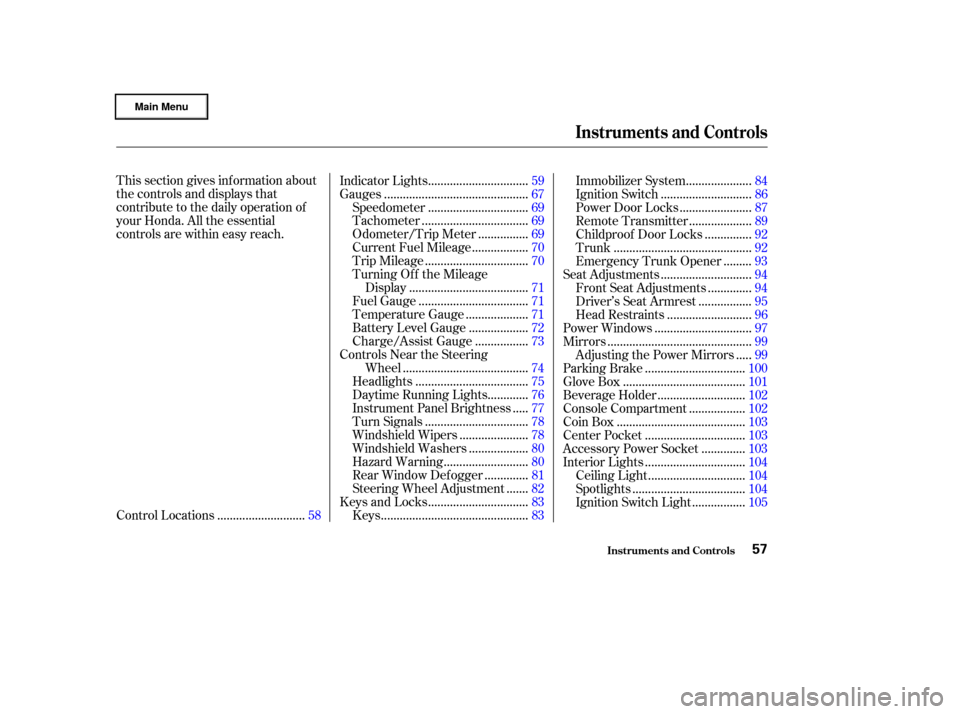
This section gives inf ormation about
the controls and displays that
contribute to the daily operation of
your Honda. All the essential
controls are within easy reach............................
Control Locations .58 ...............................
Indicator Lights .59
.............................................
Gauges .67
...............................
Speedometer .69
.................................
Tachometer .69
...............
Odometer/Trip Meter . 69
.................
Current Fuel Mileage . 70
................................
Trip Mileage .70
Turning Of f the Mileage .....................................
Display .71
..................................
Fuel Gauge .71
...................
Temperature Gauge . 71
..................
Battery Level Gauge . 72
................
Charge/Assist Gauge . 73
Controls Near the Steering .......................................
Wheel .74
...................................
Headlights .75
............
Daytime Running Lights . 76
....
Instrument Panel Brightness . 77
................................
Turn Signals .78
.....................
Windshield Wipers .78
..................
Windshield Washers . 80
..........................
Hazard Warning .80
.............
Rear Window Def ogger . 81
......
Steering Wheel Adjustment . 82
...............................
Keys and Locks .83
..............................................
Keys .83 ....................
Immobilizer System . 84
............................
Ignition Switch .86
......................
Power Door Locks .87
...................
Remote Transmitter . 89
..............
Childproof Door Locks . 92
...........................................
Trunk .92
........
Emergency Trunk Opener . 93
............................
Seat Adjustments .94
.............
Front Seat Adjustments . 94
................
Driver’s Seat Armrest . 95
..........................
Head Restraints .96
..............................
Power Windows .97
.............................................
Mirrors .99
....
Adjusting the Power Mirrors . 99
...............................
Parking Brake .100
......................................
Glove Box .101
...........................
Beverage Holder .102
.................
Console Compartment . 102
........................................
Coin Box .103
...............................
Center Pocket .103
.............
Accessory Power Socket . 103
...............................
Interior Lights .104
..............................
Ceiling Light .104
...................................
Spotlights .104
................
Ignition Switch Light . 105
Instruments and Controls
Inst rument s and Cont rols57
Page 104 of 317

Open the glove box by squeezing the
handle. Close it with a f irm push.
Glove Box
Inst rument s and Cont rols101
An open glove box can cause
serious injury to your passenger
inacrash,evenifthe
passenger is wearing the seat
belt.
Always keep the glove box
closed while driving.
Page 157 of 317
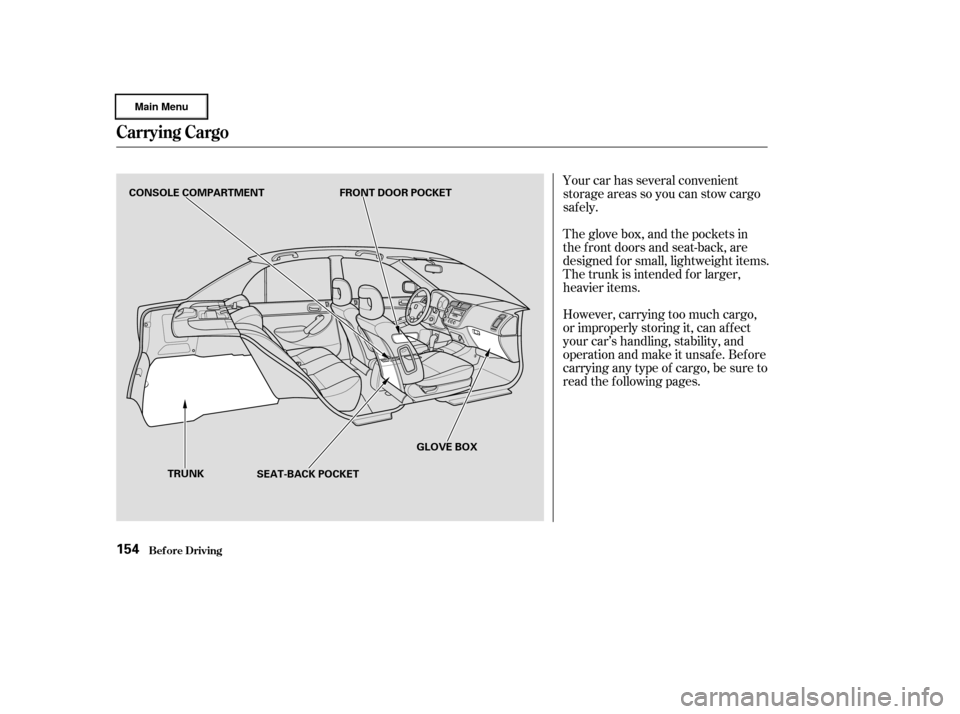
Your car has several convenient
storage areas so you can stow cargo
saf ely.
The glove box, and the pockets in
the front doors and seat-back, are
designed f or small, lightweight items.
The trunk is intended f or larger,
heavier items.
However, carrying too much cargo,
or improperly storing it, can af f ect
your car’s handling, stability, and
operation and make it unsafe. Before
carrying any type of cargo, be sure to
read the f ollowing pages.
Carrying Cargo
Bef ore Driving154
CONSOLE COMPARTMENTFRONT DOOR POCKET
TRUNK SEAT-BACK POCKET GLOVE BOX
Page 158 of 317
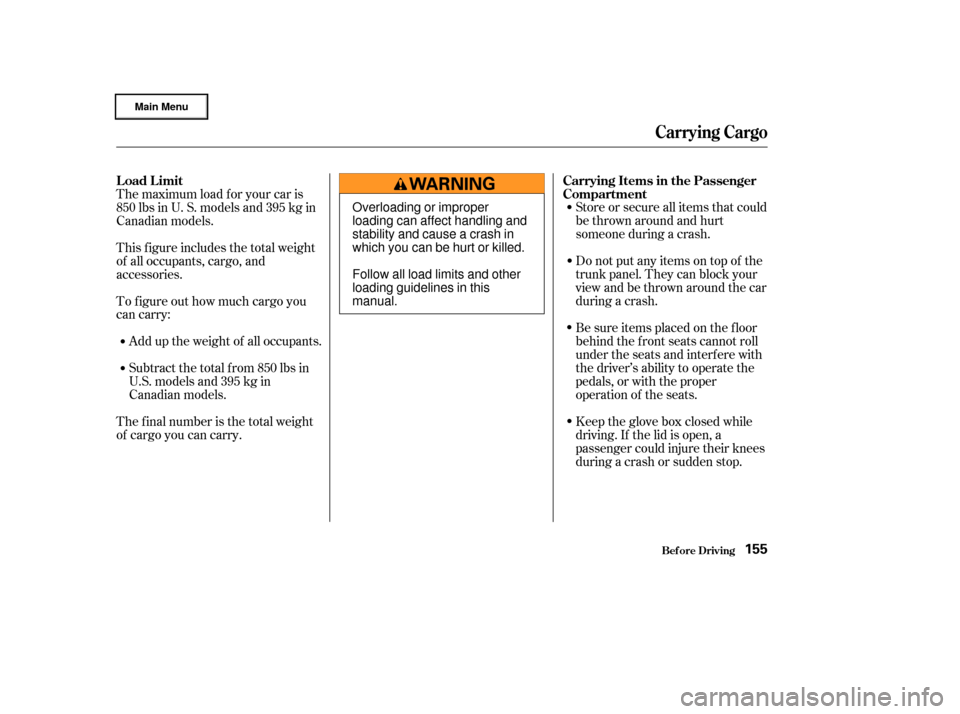
Store or secure all items that could
be thrown around and hurt
someone during a crash.
Be sure items placed on the f loor
behind the f ront seats cannot roll
under the seats and interf ere with
the driver’s ability to operate the
pedals, or with the proper
operation of the seats.
Keep the glove box closed while
driving. If the lid is open, a
passenger could injure their knees
during a crash or sudden stop. Do not put any items on top of the
trunk panel. They can block your
view and be thrown around the car
during a crash.
The maximum load for your car is
850 lbs in U. S. models and 395 kg in
Canadian models.
This f igure includes the total weight
of all occupants, cargo, and
accessories.
To f igure out how much cargo you
can carry:
Add up the weight of all occupants.
Subtract the total f rom 850 lbs in
U.S. models and 395 kg in
Canadian models.
The f inal number is the total weight
of cargo you can carry. Carrying Items in the Passenger
Compartment
Load Limit
Carrying Cargo
Bef ore Driving155
Overloading or improper
loading can affect handling and
stability and cause a crash in
which you can be hurt or killed.
Follow all load limits and other
loading guidelines in this
manual.
Page 225 of 317
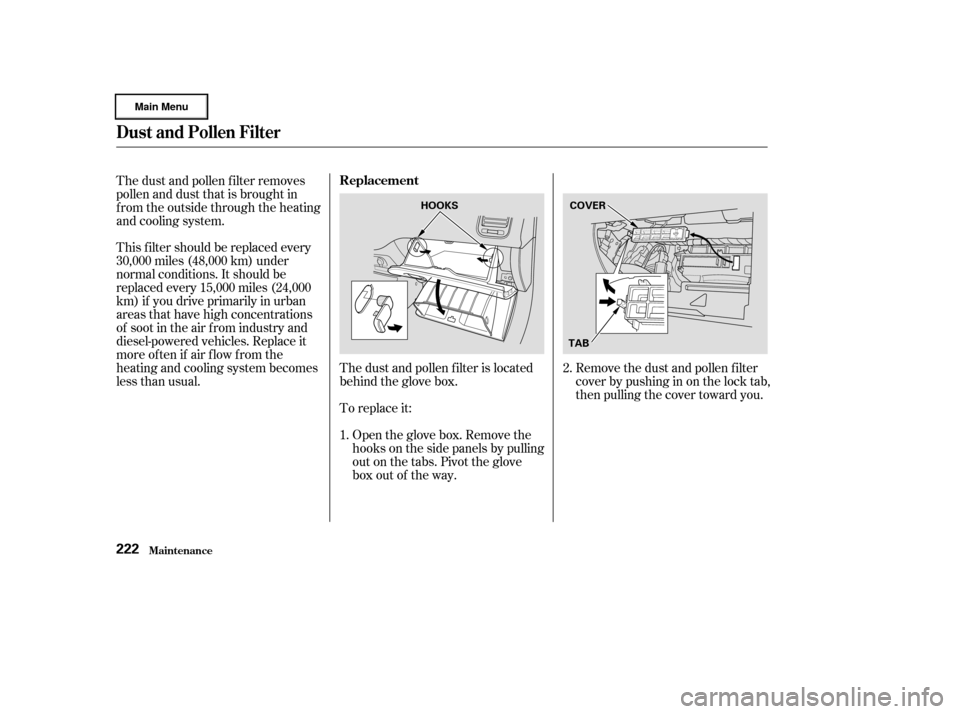
To replace it:Open the glove box. Remove the
hooks on the side panels by pulling
out on the tabs. Pivot the glove
box out of the way.
The dust and pollen f ilter is located
behind the glove box.
Remove the dust and pollen f ilter
cover by pushing in on the lock tab,
then pulling the cover toward you.
The dust and pollen f ilter removes
pollen and dust that is brought in
f rom the outside through the heating
andcoolingsystem.
This f ilter should be replaced every
30,000 miles (48,000 km) under
normal conditions. It should be
replaced every 15,000 miles (24,000
km) if you drive primarily in urban
areas that have high concentrations
of soot in the air f rom industry and
diesel-powered vehicles. Replace it
more of ten if air f low f rom the
heating and cooling system becomes
less than usual.
1.2.
Dust and Pollen Filter
Maint enance
Replacement
222
HOOKS
COVER
TAB
Page 226 of 317
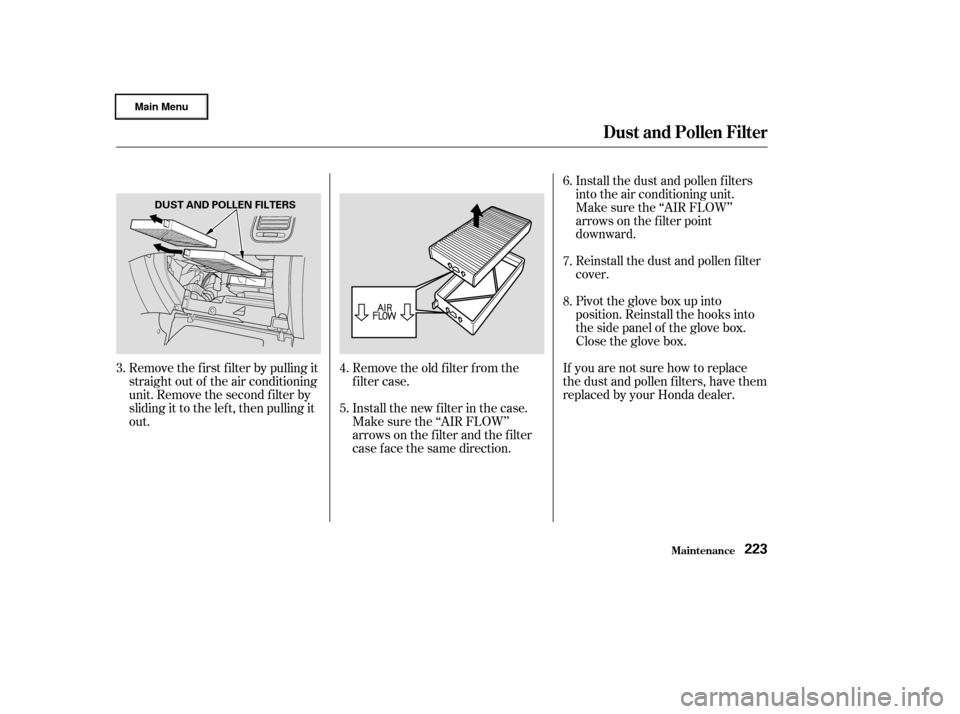
Remove the f irst f ilter by pulling it
straight out of the air conditioning
unit. Remove the second f ilter by
sliding it to the lef t, then pulling it
out.Install the dust and pollen f ilters
into the air conditioning unit.
Make sure the ‘‘AIR FLOW’’
arrows on the f ilter point
downward.
Reinstall the dust and pollen f ilter
cover.
Pivot the glove box up into
position. Reinstall the hooks into
thesidepanelof theglovebox.
Close the glove box.
If you are not sure how to replace
the dust and pollen f ilters, have them
replaced by your Honda dealer.
Remove the old f ilter f rom the
f ilter case.
Install the new f ilter in the case.
Make sure the ‘‘AIR FLOW’’
arrows on the f ilter and the f ilter
case f ace the same direction.
3.
4.
5.6.
7.
8.
Dust and Pollen Filter
Maint enance223
DUST AND POLLEN FILTERS
Page 311 of 317

.............
Halogen Headlight Bulbs . 234..............
Hazard Warning Flashers . 80
Headlights ........................................
Aiming .234
............
Daytime Running Lights . 76
..................
High Beam Indicator . 64
........................
Reminder Beeper .75
........
Replacing Halogen Bulbs . 234
...................................
Turning on .75
..............................
Head Restraints .96
.....................
Heating and Cooling .108
.............
High Altitude, Starting at . 161
.................
High-Low Beam Switch . 75
..............
High-mount Brake Light . 238
....................................
Hood Latch .212
.......................
Hood, Opening the .146
..................................................
Horn .74
...........................
Hydraulic Clutch .210
.................................
Hydroplaning .179
...
Identif ication Number, Vehicle . 286
Ignition ..............................................
Keys .83
...........................................
Switch .86
............
Timing Control System . 295
5-speed Manual Transmission
...............
Checking Fluid Level . 208
................................
Shif ting the .162
.............
Flashers, Hazard Warning . 80
...................
Flat Tire, Changing a . 257
Fluids Automatic Transmission .....................................
(CVT) .206
..........................................
Brake .209
.........................................
Clutch .210
..............
Manual Transmission . 208
..................
Windshield Washer . 205
FM Stereo Radio ...................................
Reception .125
.....
Foreign Countries, Driving in . 293
..........................
Four-way Flashers .80
............................
Front Airbags .10, 48
.................................................
Fuel .144
......................
Fill Door and Cap .145
...........................................
Gauge .71
................
Octane Requirement . 144
...............................
Oxygenated .292
........................
Reserve Indicator .65
........................
Tank, Filling the .145
.....................
Fuses, Checking the .276 ...............
Gas Mileage, Improving . 150
..........................................
Gasohol .292
.........................................
Gasoline .144
...............
Fuel Reserve Indicator . 65
...........................................
Gauge .71
................
Octane Requirement . 144
........................
Tank, Filling the .145
................
Gas Station Procedures . 145
Gauges ...
Engine Coolant Temperature . 71
...............................................
Fuel .71
...............................
Speedometer .69
.................................
Tachometer .69
Gearshif t Lever Positions Automatic Transmission .....................................
(CVT) .167
5-speed Manual .........................
Transmission .162
..............................
Glass Cleaning .251
......................................
Glove Box .101
Index
G
H I
IV